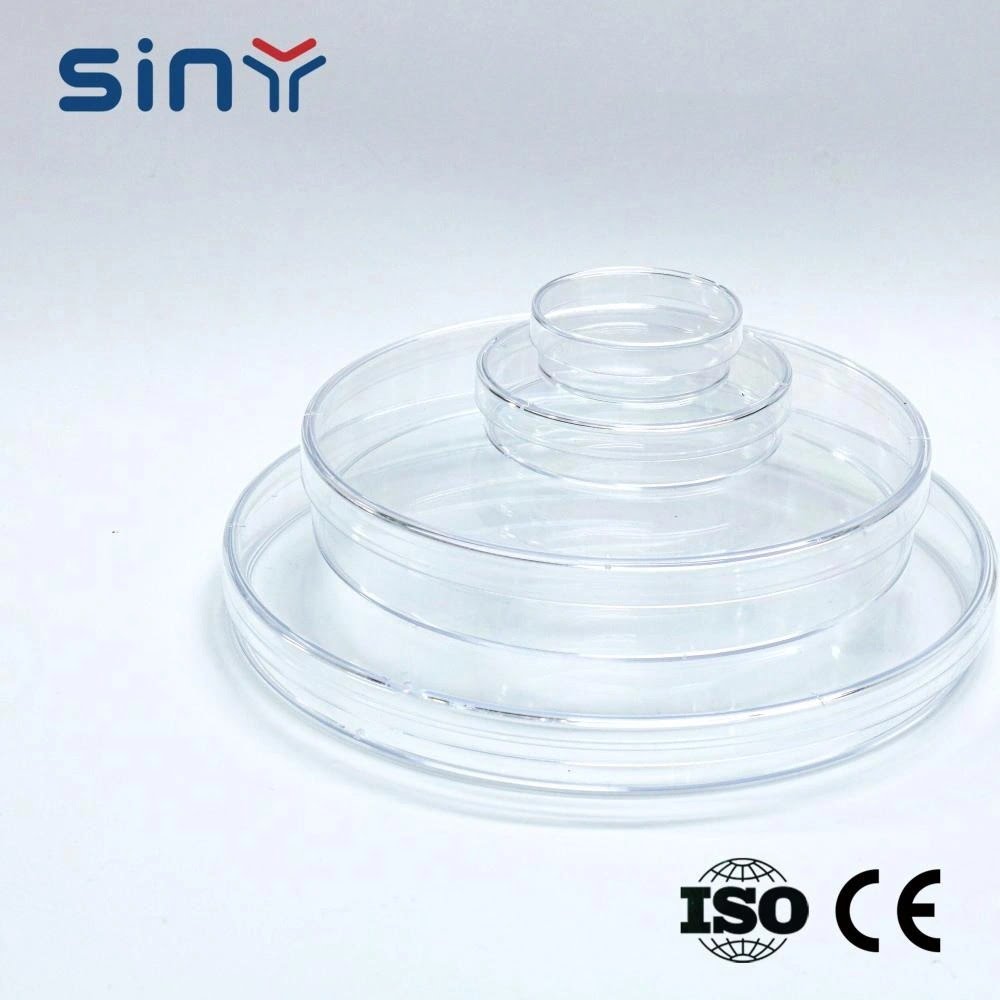Three types of culture vessels are commonly used in laboratory settings, particularly in microbiology and cell culture: Petri dishes, Petri flasks, and Petri plates. Each of these vessels has unique characteristics, applications, and advantages that make it suitable for different experimental needs. This comprehensive overview will explore their differences in detail, covering aspects such as shape and structure, capacity and cultivation area, uses based on experimental needs, materials, and best practices for selection.
Petri dishes, Petri flasks, and Petri plates are essential tools in biological and microbiological laboratories, each serving distinct purposes based on their design, structure, and intended use.
Table of Contents
- 1 Shape & Structure
- 2 In Terms of uses
- 3 Capacity and cultivation area
- 4 How do you choose a petri dish, culture bottle, or culture plate based on experimental needs?
- 5 What materials are used for culture dishes, bottles, and plates?
- 6 Summary of Differences
- 7 Final Thoughts
- 8 FAQs
- 8.1 What is a Petri dish?
- 8.2 How do Petri flasks differ from Petri dishes?
- 8.3 What are the different types of Petri plates?
- 8.4 Can Petri dishes be reused?
- 8.5 How should I properly handle and store Petri dishes?
- 8.6 What materials are commonly used to make Petri dishes?
- 8.7 What should I do with the Petri dishes I use?
- 9 You May Also Read
Shape & Structure
Petri dishes
Cell culture dishes are generally flat, round glass or plastic vessels. They consist of a bottom and a lid. The bottom is usually shallow, and the lid is slightly larger, which can cover the bottom and facilitate observation of the culture. Common cell culture dishes have diameters of 35mm, 60mm, 100mm, and other specifications.

Culture flask
It is usually a container with a bottleneck and a bottle body, and its shape resembles an ordinary bottle. The design provides a relatively closed culture environment, and the bottleneck effectively reduces the entry of external pollution into the bottle. Culture flasks have different shapes, such as square, round, etc., and have a variety of specifications, with capacities of 25 cm2, 75 cm2, 175 cm2, etc. Some culture flasks also have breathable caps to ensure gas exchange in the bottle, meet the needs of cells and other cultures for oxygen and other gases, and prevent microbial contamination. This shape makes the culture flask ideal for long-term cell culture, particularly for suspension cell culture plate or when researchers need a large volume of culture.
Culture plate
Culture dishes are usually flat, regular-shaped containers that resemble shallow boxes. Its depth may be slightly more profound than a culture dish’s, but it is not a three-dimensional bottle shape like a culture bottle. It can have multiple partitions, such as the typical 6-well culture dish, 12-well culture dish, 24-well culture dish, etc. You can use these partitions to culture multiple different samples simultaneously or conduct comparative experiments.
In Terms of uses
Petri dishes
Researchers often use Petri dishes for solid plate cultures of microorganisms, such as bacteria and fungi. They pour the culture medium containing microorganisms into the Petri dish, and once it solidifies, they inoculate the surface of the plate with the microorganisms. Observing the morphology, size, color, and other characteristics of the colony allows researchers to identify the type of microorganism present.
Culture flask
They are mainly used for large-scale cell culture flask, especially adherent cells. Adherent cells need to attach to the inner wall of the culture bottle to grow, and the culture bottle provides sufficient surface area for cells to attach. In tissue engineering and biopharmaceuticals, researchers commonly use culture bottles as containers when producing biological products or constructing tissue engineering products with many cell cultures.

Culture plate
You can use the multiple compartments to conduct comparative experiments on different treatment factors of cells culture plate during cell experiments.

Capacity and cultivation area
Petri dishes
The capacity is relatively small, mainly determined by its diameter and depth. The culture area is circular at its bottom and is usually used for small sample cultures.
Culture bottle
The capacity varies according to its specifications, and the range is wide. The culture area is mainly the inside of the bottle wall. It can provide a larger cell growth area and is suitable for culturing many cells.
Culture dish
The capacity and culture area of each well vary depending on the number of wells. The capacity is about 0.5–1 ml. This design allows small-volume culture in each well, and multiple samples can be operated in parallel.
How do you choose a petri dish, culture bottle, or culture plate based on experimental needs?
Selection based on culture type
Microbial culture
When performing solid cultures of microorganisms, such as counting bacteria or observing the morphology of fungi, researchers should choose culture dishes as their first option. The design of these dishes allows for easy pouring of the culture medium containing agar and other coagulants, creating a solid plate. Microorganisms then grow on the surface of the plate, forming colonies that are convenient for observation and counting.
Culture bottles are more suitable for liquid culture of microorganisms, such as bacterial fermentation experiments. They can accommodate more liquid culture medium, and the bottleneck design is conducive to reducing pollution and providing a relatively closed and stable growth environment for microorganisms.
For example, In the microbial fermentation process of producing antibiotics, researchers use large-capacity culture bottles to cultivate microbial strains that produce these antibiotics.
Cell culture
Culture bottles are a better choice for large-scale culture of adherent cells. Adherent cells need to attach to the wall of the container to grow. Culture bottles have a large surface area for cells to attach to and can ensure sufficient space and nutrient supply.
Small sample size or a small number of experimental treatment groups: When the experiment involves only a small number of samples or experimental treatment groups, culture dishes can meet the needs.
For example, When you initially explore a new microbial culture condition, you only need a few culture dishes to set different temperatures, pH levels, and other conditions to observe the growth of microorganisms.
For cell experiments, if you are conducting simple cell observations or processing a small amount of samples—such as comparing the growth rates of two cell lines under the same conditions—you can use a culture dish or a small-sized culture plate, like a 6-well plate.
Large-scale experiments or large-scale sample processes require many cells, and the large capacity and scalability of culture bottles make them an inevitable choice for large-scale cell culture, such as the production of monoclonal antibodies and other biological products in biopharmaceuticals.You can expand the culture scale by using multilayer cell culture bottles or multiple large-capacity culture bottles.In high-throughput screening experiments, researchers must process hundreds of thousands of samples to examine the effects of various compounds on cells.
At this time, using 96-well or 384-well culture plates can efficiently conduct experiments and process and observe a large number of samples in a short time.
What materials are used for culture dishes, bottles, and plates?
Glass material
One of the key benefits of glass is its ability to maintain the integrity of the culture environment. Its chemical stability ensures that glass culture dishes, bottles, and plates do not react with the culture, thereby preserving its strength.
When it comes to observing cultures, glass is the material of choice. Its optical properties ensure a clear view of cell or microorganism growth under a microscope without blurring or deformation. This long-lasting transparency provides a level of consistency that you can rely on in your research.
Glass is frequently sterilized using high-pressure steam and can tolerate high temperatures. This method is used in laboratories. Microorganisms on the surface of the culture container can be efficiently eliminated by high-pressure steam sterilization, which also guarantees the sterility of the culture procedure. Sterilization is usually possible at 121°C and 15–20 pounds of pressure. The glass’s chemical and physical characteristics essentially do not change after sterilization.
Plastic material
Plastic culture containers are not only light and easy to handle, but they also offer a significant safety advantage. Their toughness and disposability make them ideal for experiments that require strict sterility or need to avoid cross-contamination, providing a level of safety that can give you peace of mind in the laboratory.
Summary of Differences
| Feature | Petri Dish | Petri Flask | Petri Plate |
|---|---|---|---|
| Shape | Shallow, cylindrical | Wider body with narrow neck | Flat with multiple wells |
| Material | Glass or plastic | Glass or plastic | Usually plastic |
| Capacity | Small (20 – 30 ml) | Larger (up to several hundred ml) | Small per well (0.5 – 2 ml) |
| Primary Use | Microbial culturing | Large-scale cell culture | High-throughput screening |
| Contamination Risk | Moderate | Low | Higher |
| Observation | Easy through transparency | More difficult due to neck | Easy through transparency |
Final Thoughts
Understanding the distinctions between Petri dishes, Petri flasks, and Petri plates is crucial for researchers in biological sciences. Each vessel has unique characteristics that cater to different experimental needs—whether culturing microorganisms on solid media, growing cells in liquid environments, or conducting high-throughput experiments. Scientists can optimize their research outcomes effectively by selecting the appropriate vessel based on specific requirements such as scale, type of culture, and contamination risks.
FAQs
What is a Petri dish?
A Petri dish is a shallow, cylindrical container with a lid used primarily in laboratories for culturing microorganisms. Researchers typically make Petri dishes from glass or plastic, and they fill them with a growth medium, such as agar, to cultivate bacteria, fungi, or other cells. The design allows for easy observation of microbial growth without environmental contamination.
How do Petri flasks differ from Petri dishes?
Petri flasks, also known as culture flasks, have a wider body and a narrow neck compared to Petri dishes. This design allows them to hold larger volumes of liquid culture medium and provides a more controlled environment for growing cells. Flasks are particularly suitable for researchers conducting long-term cultures of adherent cells or microbial fermentation processes, while scientists primarily use Petri dishes for solid media cultures.
What are the different types of Petri plates?
Petri plates can refer to configurations, including standard Petri dishes and multi-well plates (like 6-well or 96-well plates). Multi-well plates allow researchers to conduct high-throughput experiments by culturing multiple samples simultaneously in separate wells. This design is efficient for testing different conditions or treatments across several samples at once
Can Petri dishes be reused?
Yes, glass Petri dishes can be reused after proper sterilization through autoclaving or other methods. However, many laboratories opt for disposable plastic Petri dishes to minimize contamination risks and save time on cleaning and sterilization processes. The choice between reusable and disposable options often depends on the specific needs of the experiment.
How should I properly handle and store Petri dishes?
- To ensure the integrity of Petri dishes, Work in a clean and sterile environment.
- Use sterilized tools when handling dishes to avoid contamination.
- Seal used dishes tightly with parafilm or suitable materials to prevent contamination exposure.
- Store them in a cool, dry place away from direct light.
Regularly inspect stored dishes for any signs of damage or contamination.
What materials are commonly used to make Petri dishes?
Manufacturers typically make Petri dishes from glass or plastic. They often use borosilicate glass for glass dishes because it is heat-resistant and can withstand multiple sterilizations. For plastic dishes, manufacturers usually choose polystyrene or polypropylene, which are lightweight and disposable but may not endure high temperatures.
What should I do with the Petri dishes I use?
- If used Petri dishes contain microbial cultures, they should be treated as biohazardous waste. Before disposal, Decontaminate them using autoclaving or another approved method.
- Place decontaminated dishes in biohazard bags designated for biological waste disposal.
- Follow your laboratory’s biosafety guidelines for proper disposal procedures.
By adhering to these practices, you can ensure safety and compliance with laboratory standards while using Petri dishes, flasks, and plates effectively in your research.
You May Also Read
- What is a Petri Dish?
- Why use Petri dishes?
- What are the differences between TC culture dishes and Non-TC culture dishes?
If you enjoyed this article, please subscribe to our YouTube channel. We provide product video tutorials. You can also follow us on Instagram and Facebook to stay up to date with new updates, news and special deals.



























































